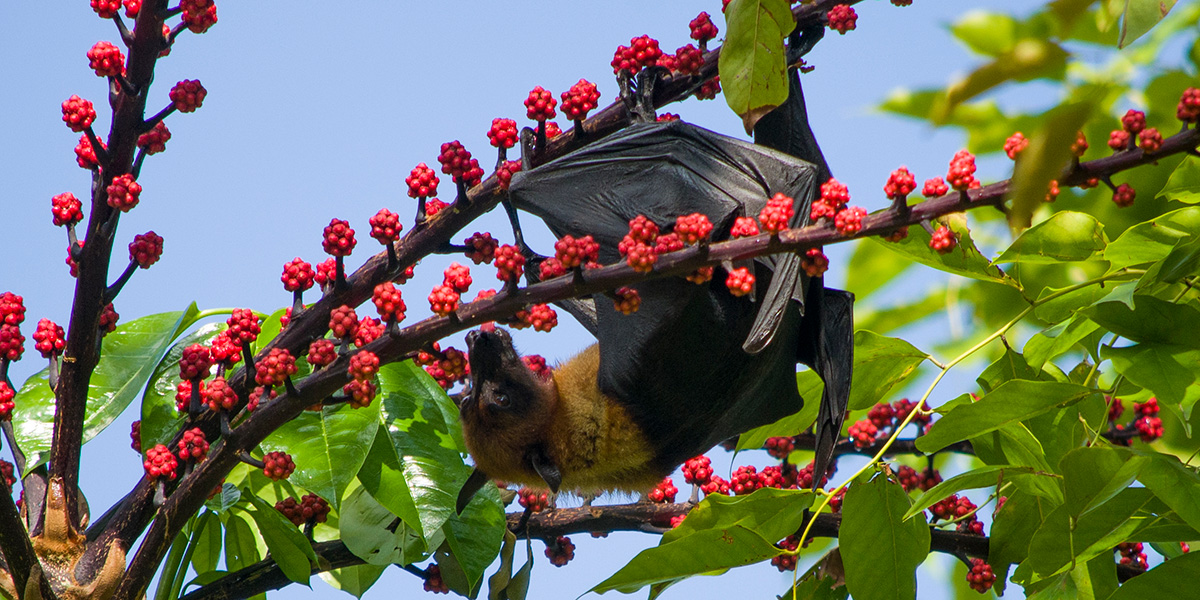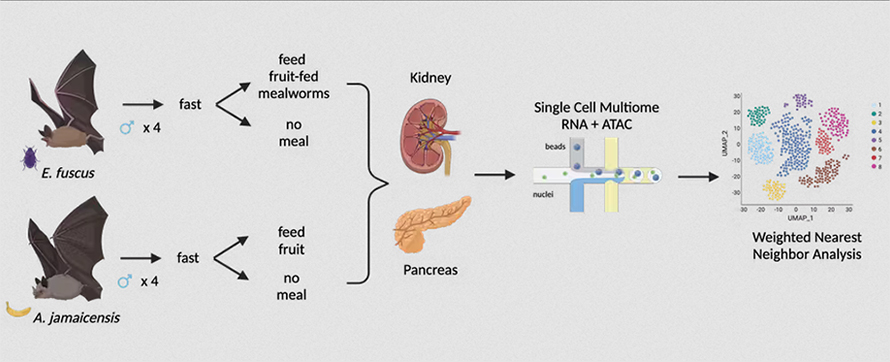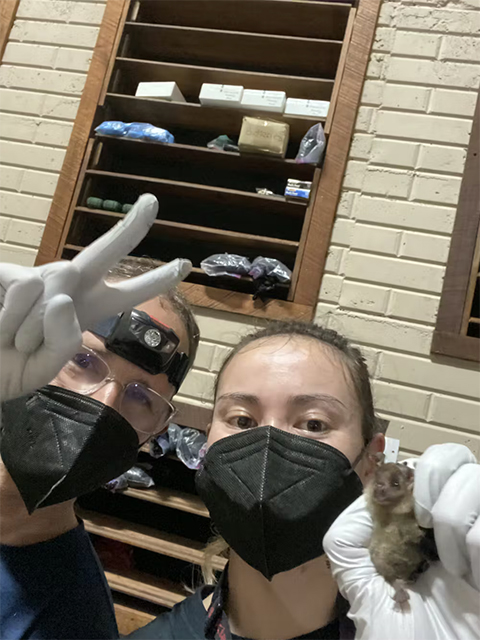Why don’t fruit bats get diabetes?
People around the world eat too much sugar. When the body is unable to process sugar effectively, leading to excess glucose in the blood, this can result in diabetes. According to the World Health Organization, diabetes became the ninth leading cause of death in 2019.

Keith Rose/iStock
Humans are not the only mammals that love sugar. Fruit bats do, too, eating up to twice their body weight in sugary fruit a day. However, unlike humans, fruit bats thrive on a sugar-rich diet. They can lower their blood sugar faster than bats that rely on insects as their main food source.
We are a team of biologists and bioengineers. Determining how fruit bats evolved to specialize on a high-sugar diet sent us on a quest to approach diabetes therapy from an unusual angle – one that sent us all the way to Lamanai, Belize, for the Belize Bat-a-thon, an annual gathering where researchers collect and study bats.
In our newly published research in Nature Communications, we and colleagues Seungbyn Baek and Martin Hemberg used a technology that analyzes the DNA of individual cells to compare the unique metabolic instructions encoded in the genome of the Jamaican fruit bat, Artibeus jamaicensis, with those in the genome of the insect-eating big brown bat, Eptesicus fuscus.
Approximately 2% of DNA is composed of genes, which are segments of DNA that contain the instructions cells use to create certain traits, such as a longer tongue in fruit bats. The other 98% are segments of DNA that regulate genes and determine the presence and absence of the traits they encode.
To understand how fruit bats evolved to consume so much sugar, we wanted to identify the genetic and cellular differences between bats that eat fruit and bats that eat insects. Specifically, we looked at the genes, regulatory DNA and cell types in two significant organs involved in metabolic disease: the pancreas and the kidney.
The pancreas regulates blood sugar and appetite by secreting hormones like insulin, which lowers your blood sugar, and glucagon, which raises your blood sugar. We found Jamaican fruit bats have more insulin-producing and glucagon-producing cells than big brown bats, along with regulatory DNA that primes fruit bat pancreatic cells to initiate production of insulin and glucagon. Together these two hormones work to keep blood sugar levels balanced even when the fruit bats are eating large amounts of sugar.
The kidney filters metabolic waste from the blood, maintains water and salt balance and regulates blood pressure. Fruit bat kidneys need to be equipped to remove from their bloodstreams the large amounts of water that come from fruit while retaining the low amounts of salt in fruit. We found Jamaican fruit bats have adjusted the compositions of their kidney cells in accordance with their diet, reducing the number of urine-concentrating cells so their urine is more diluted with water compared with big brown bats.

Why it matters
Diabetes is one of the most expensive chronic conditions in the world. The U.S. spent US$412.9 billion in 2022 on direct medical costs and indirect costs related to diabetes.
Most approaches to developing new treatments for diabetes are based on traditional laboratory animals such as mice because they are easy to reproduce and study in a lab. But outside the lab, there exist mammals like fruit bats that have actually evolved to withstand high sugar loads. Figuring out how these mammals deal with high sugar loads can help researchers identify new approaches to treat diabetes.
By applying new cell characterization technologies on these nonmodel organisms, or organisms researchers don’t usually use for research in the lab, we and a growing body of researchers show that nature could be leveraged to develop novel treatment approaches for disease.
What still isn’t known
While our study revealed many potential therapeutic targets for diabetes, more research needs to be done to demonstrate whether our fruit bat DNA sequences can help understand, manage or cure diabetes in humans.
Some of our fruit bat findings may be unrelated to metabolism or are specific only to Jamaican fruit bats. There are close to 200 species of fruit bats. Studying more bats will help researchers clarify which fruit bat DNA sequences are relevant for diabetes treatment.
Our study also focused only on bat pancreases and kidneys. Analyzing other organs involved in metabolism, such as the liver and small intestine, will help researchers more comprehensively understand fruit bat metabolism and design appropriate treatments.
What’s next
Our team is now testing the regulatory DNA sequences that allow fruit bats to eat so much sugar and checking whether we can use them to better regulate how people respond to glucose.
We are doing this by swapping the regulatory DNA sequences in mice with those of fruit bats and testing their effects on how well these mice manage their glucose levels.
This article is republished from The Conversation under a Creative Commons license. Read the original article.
![]()
Enjoy reading ASBMB Today?
Become a member to receive the print edition four times a year and the digital edition monthly.
Learn moreGet the latest from ASBMB Today
Enter your email address, and we’ll send you a weekly email with recent articles, interviews and more.
Latest in Science
Science highlights or most popular articles

Exploring the link between lipids and longevity
Meng Wang will present her work on metabolism and aging at the ASBMB Annual Meeting, March 7-10, just outside of Washington, D.C.

Defining a ‘crucial gatekeeper’ of lipid metabolism
George Carman receives the Herbert Tabor Research Award at the ASBMB Annual Meeting, March 7–10, just outside of Washington, D.C.

The science of staying strong
Muscles power every movement, but they also tell the story of aging itself. Scientists are uncovering how strength fades, why some species resist it and what lifestyle and molecular clues could help preserve muscle health for life.

Bacteriophage protein could make queso fresco safer
Researchers characterized the structure and function of PlyP100, a bacteriophage protein that shows promise as a food-safe antimicrobial for preventing Listeria monocytogenes growth in fresh cheeses.

Building the blueprint to block HIV
Wesley Sundquist will present his work on the HIV capsid and revolutionary drug, Lenacapavir, at the ASBMB Annual Meeting, March 7–10, in Maryland.

Gut microbes hijack cancer pathway in high-fat diets
Researchers at the Feinstein Institutes for Medical Research found that a high-fat diet increases ammonia-producing bacteria in the gut microbiome of mice, which in turn disrupts TGF-β signaling and promotes colorectal cancer.



